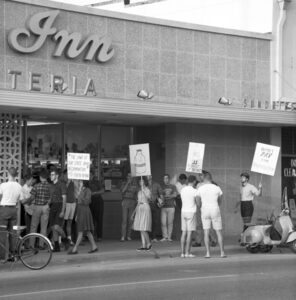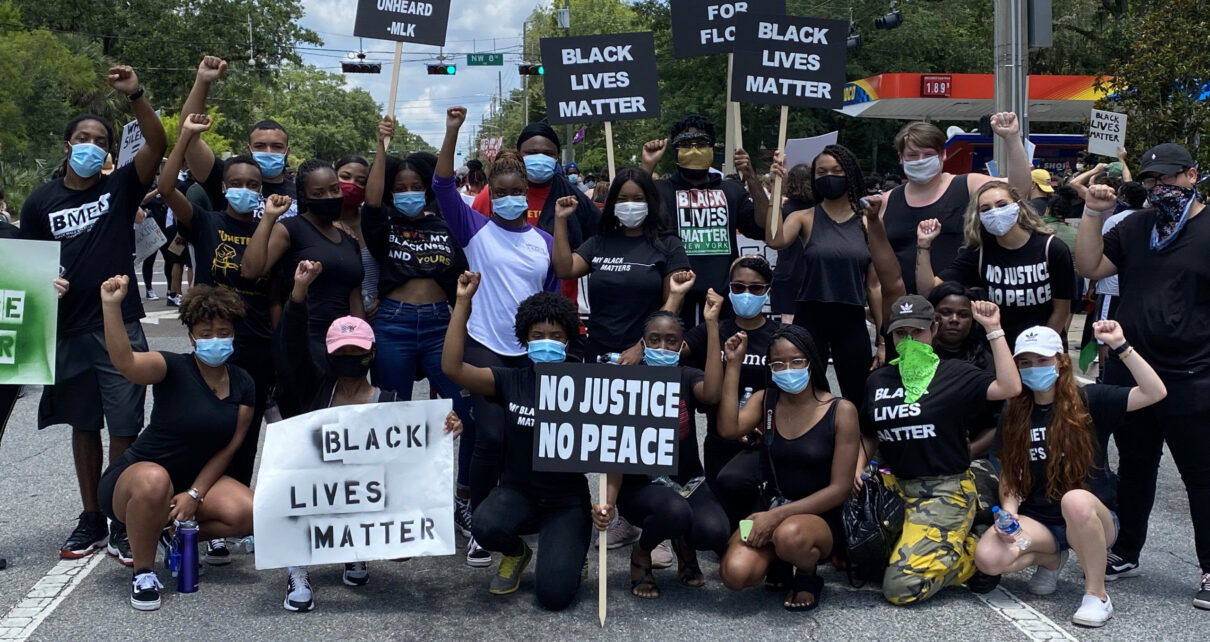By Brooks Bass, Morgan Goldwich, Kevin Maher, Michaela Mulligan, Emma Ross and Thomas Weber
May 20, 2021 Florida Good, Longform, Racial equity
Thursday marks one month since former Minneapolis police officer Derek Chauvin was found guilty of murdering George Floyd.
And Tuesday is one year since Floyd’s death, an event that sparked months-long protests across the country in support of the Black Lives Matter movement.
In Gainesville, over 1,000 community members came together to march through the city last summer. Many of them were students at the University of Florida, carrying on Gainesville’s significant legacy of student activism, dating back to the Civil Rights Movement of the 1950s and ‘60s.
Since the Civil Rights Movement, groups of UF students and Gainesville community members have used their voices to promote racial equality and justice. Through the decades that have followed, Gainesville’s racial and political landscape has changed. While the reason for this fight has remained similar, the means and voices have changed with new technology and legislation.

Peaceful protest against discrimination outside College Inn across from the University of Florida campus. (Photo: Carolyn and Samuel Johnston). Dan Harmeling later joined UF’s Student Group for Equal Rights and would picket the College Inn, a restaurant known for denying service to Black people that once stood where Social, located at 1728 W University Ave., now stands.
Voices of Gainesville’s Past
Denifield Player, a Black man, was one of the first people who organized against civil rights disparities in Gainesville. In 1963, Player went to downtown Gainesville Woolworth’s, a whites-only lunch counter, with his brother and two friends. They were refused service on the basis of their skin color.
Player and his friends began testing other restaurants in Gainesville to see who would serve them. With the encouragement of his pastor, Player and his friends organized the National Association for the Advancement of Colored People Youth Council in a direct effort to integrate restaurants and movie theaters.
Player as a teenager worked at the Florida Theatre, a whites-only theater in Gainesville. White audiences would often throw popcorn at him while cleaning isles. In 1963, two Black men were denied tickets to the same theater and refused to leave, which resulted in picketing. Player said the demonstration was met with venom, but not violence.
After continued picketing, particularly at the Florida Theatre, the city of Gainesville formed a biracial committee in the summer of 1963.
“That committee negotiated the integration of the movie theaters and the restaurants here in the city. And that’s how everything got started,” Player, 81, said.
Dan Harmeling, a white student, started at UF in Fall 1962, a semester when the school admitted only seven Black students. He and his brother, Jim Harmeling, would later become prominent activists in the Civil Rights Movement. In the summer of ‘63, they heard about the demonstration at the Florida Theatre on the radio. That evening, they went to the NAACP Youth Chapter meeting and signed up to picket at segregated restaurants around Gainesville.
Dan Harmeling recalled that he was usually only joined by about 25 people when picketing.
Now, as the university and the city of Gainesville has grown, so too has its activism. Some 60 years later, the students and faculty at the university continue to advocate for the fair treatment of Black people.
The University Through the Years
In 1962, there were just a handful of Black students at UF. Harmeling estimates there were around 10,000 to 15,000 students attending, making the population of Black students far less than 1%.
Today, UF’s population of Black students is at 6.7%, well below the statewide Black population of 17%.
Player, however, was not allowed to attend UF in 1957. After growing up in Gainesville, he had to leave his hometown to attend college. UF wasn’t accepting Black students at the time, so Player graduated from Howard University. He would later return to Gainesville as a faculty member at UF.
“The irony was that when I graduated high school, I wasn’t allowed to attend the University of Florida,” Player said. “We were allowed to take the test, the entrance exam, but we weren’t allowed to attend the University of Florida, so I ended up going to Howard University in Washington D.C., and came back and got a job on the faculty. So, I find a little irony in that.”
The university did not begin admitting Black students until over a century after its founding. Dan Harmeling said the administration saw UF’s desegregation efforts as an experiment.
“My attitude about the administration — this was J. Wayne Reitz and Lester Hale and Dean Grinter, and all these names you hear all the time, and O’Connell,” Harmeling said. “As far as they were concerned, it was an experiment, and it seemed like they were … hoping that it would fail.”
Marshall B. Jones, a former UF assistant professor of psychiatry and psychology, discusses his difficulties with UF’s administration as a white activist in a memoir titled “Berkeley of the South: A History of the Student Movement at the University of Florida, 1963-1968.”
In the book, he shares how Reitz denied his tenure after Jones’ own department had already approved it. There was a subsequent trial before the Senate Committee on Academic Freedom and Tenure in 1968, with Stephen C. O’Connell, Reitz’s predecessor, who continued to deny tenure.
Jones wrote that he was seen by O’Connell and Reitz as a “radical” with too much influence on UF’s student body. He originated the Student Group for Equal Rights and was a published author advocating for the resistance against the treatment of Black people in the 1960s.
According to Jones’ memoir, the administration cited an article he wrote for an academic journal advocating for resistance as the reason for his denial of tenure.
“The administration regarded my presence on campus as a threat to the institution as it was constituted, and Reitz … had the forthrightness to say so,” Jones wrote.
However, during Jones’ trial, Reitz stated Jones encouraged students at every chance to confront authority. In the memoir, Jones reflects on a specific trip to St. Augustine, where he and other students protested for Black rights. Many students, including Harmeling and Jones, were arrested.
The New Faces of Activism
This past summer, over 1,000 people marched against police brutality in multiple organized marches in Gainesville.
Tiffany Pennamon, 26, is a graduate student and journalist at UF’s Smathers Libraries, Special and Area Studies Collections. Pennamon is studying African American literature and cultural studies and has documented community protests. She helped curate a historical display in the George A. Smathers Libraries and participated in some of the marches during summer 2020.
Despite the major difference in size between today’s activism, Pennamon said she sees some parallels between now and the past. For example, she said she noticed a mix of student and community-based involvement during last summer’s marches.
Pennamon said she noticed another difference between the movements — during last summer’s marches, there was support for a wider spectrum of people. For example, she said she saw a protestor holding a sign that said “Black Lives Matter” in American Sign Language.
“That also reminded me of just the accessibility and the range of people that are participating in this movement,” Pennamon said. “Sometimes we forget that there’s sub-movements within larger movements.”
She said the attention given toward the different identities and groups within the Black community — such as Black women, queer and trans folks, or disabled people — helps raise awareness for those who are oppressed or marginalized in more than one way.
But for Pennamon, some of the parallels are also disheartening.
“I’m sad because we still are fighting the same fight that our elders have had to fight before,” she said.
Dan Harmeling, along with other students from UF, traveled to Tallahassee to meet up with students from Florida A&M. It was during one of the demonstrations in Tallahassee that Harmeling was arrested along with 348 other students. (Michaela Mulligan/WUFT News)
In the end, Jones was not afforded tenure in a 3-2 decision siding with UF’s administration.
Gainesville’s Progress
The City of Gainesville’s local government has undergone a significant transition in the past three years. It’s seen a number of new city positions filled by people of color, particularly women of color. This is a historic turn from just five years prior, when many positions of power were only held by white men. In almost all levels of local public office, a person of color now holds a major position.
In 2018, Gail Johnson and Gigi Simmons were elected to Gainesville’s City Commission. It was the first time in the city’s history that two Black women would serve on the commission. Johnson was recently reelected, but Simmons was beat out by Desmon Duncan-Walker, another Black woman, for the District 1 seat. The seat includes much of East Gainesville and the Porters community and has not won a second term in nearly 10 years.
In Gainesville’s court system, Meshon Rawls and Gloria Walker, two Black women, were elected to the area’s judicial seats in 2019. This was the first time in the area’s history that two Black women would serve as judges at the same time. On a larger scale, Clovis Watson Jr. was elected as the first Black sheriff of Alachua County in August 2020, three months after George Floyd’s murder. Watson ran on a policy of reform, suggesting the use of diversion programs and more reflection on police practices.
Education equity has been an ongoing conversation in Gainesville. In 1970, Lincoln High School, Gainesville’s high school for Black students, was closed. This closure led to more integration within other Gainesville high schools, especially Gainesville High. Tensions were still high between the groups, and on March 26, 1970, a riot broke out at Gainesville High School after a group of white students raised a confederate flag on the victory pole.
The achievement gap between Black and white students is one of the ways racial disparities in Alachua County are measured. This gap, which is based on factors such as reading performance and economic status, was found to have widened in recent years.
In 2019, the Alachua County School Board outlined plans to close this gap. The school board plans to close the achievement gap by 2028, through specific goals like “student achievement,” “advanced coursework,” “diversity in the workforce” and more. This plan comes just one year after Alachua County placed two Black women on its school board for the first time in its history. In 2020, after Diyonne McGraw won a seat on the Alachua County School board, it marked the first time in Alachua history that three Black women held a majority on the board.
Activism Moving Forward
In the 1960s, inclusivity was not a goal of UF. It wasn’t until 2018, nearly 60 years later, that UF hired its first chief diversity officer, Antonio Farias, and created the Diversity, Equity & Access (IDEA) Network, a major step toward promoting inclusivity on the campus.
Farias resigned from his role in mid-March, prompting the university to search for a new officer. Mary Watt, a member of the IDEA network and associate Dean for the College of Liberal Arts and Sciences (CLAS), is on the search committee for a new chief diversity officer.
Like other colleges at the university, CLAS has its own diversity and inclusion committee called the Steering Committee. CLAS created the committee in 2016 and works with each department, overseeing best policies and initiatives for inclusivity and diversity.
The Steering Committee and other diversity, equity and inclusion college representatives at UF expressed their inability to recruit students of color, despite their own efforts of outreach and inclusion.
Lawrence Ukeiley, a member of the IDEA Network for the Department of Mechanical & Aerospace Engineering, said the university handles undergraduate recruitment, not an individual college. The Department of Mechanical & Aerospace Engineering can, however, control their graduate recruitment, and make the undergraduate students in its program feel welcome.
“We’re starting some new undergraduate research fellowships for under-represented groups with the hopes of trying to engage some more of our undergraduates in those groups who do want to go to graduate school and become professors,” Ukeiley said. “That’s more of the knob that we feel that we can… turn to try to adjust.”
Watt said CLAS is actively looking to recruit more faculty of color.
CLAS is working to make African American studies, currently an undergraduate major, into a department. The college is doing what’s called a “cluster hire,” hiring five new professors in African American studies. The hope is that the cluster hire will create a community both scholarly and socially.
As these institutional changes are slowly but surely implemented, certain social practices have allowed instances of inequality to be brought to the forefront of mainstream conversation.
Dr. Zoharah Simmons, a retired UF professor of religion, said she thinks the prevalence of social media has allowed issues of social justice to spread more widely than what was possible during the Civil Rights era.
“I think these platforms and posting and exchanging, I think it’s very important,” Simmons said. “And I think we saw what it can do after the George Floyd murder. I mean, they say those were the largest demonstrations that have ever been held in this country. And so they were made possible by social media, and it wouldn’t have happened otherwise. So I think that is a big part of the new toolbox.”
For others, the use of social media seems to muddle the true efforts of certain movements.
“Instagram activism really annoys me,” said Anthony Hester, a philosophy major at UF who attended the Black Lives Matter protests. “There’s one thing about getting your message out, but there’s another thing about like, centering yourself around the message, which I feel like is a problem.”
The legacy of activism in Gainesville has continued for the past 60 years, but Twanna Hodge, UF’s first Diversity, Equity and Inclusion Librarian, said it’s an effort that will go far into the future. Hodge said activists are working toward a world that doesn’t currently exist, and it’ll take work and time.
“Some things are going to happen incrementally, and some things are going to happen like a flash fire,” Hodge said. “But, you know we don’t get an opt out. Time for opting out is, it’s been passed.”








